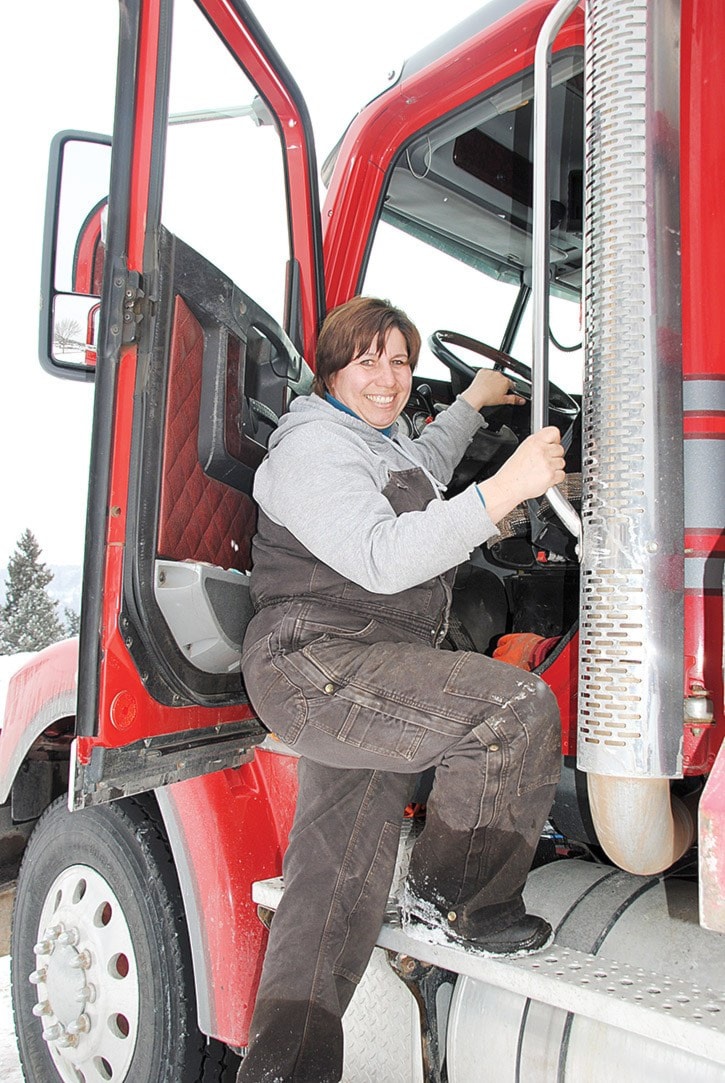When you are a young girl who loves horses and is looking to make big money to feed your passion, where do you turn?
For Simmone Fowler, log trucking proved to be the perfect answer.
“I was young and I was into horses and there weren’t a lot of jobs where you could make lots of money without a big education,” Simmone says. “My dad had trucks and the neighbours had trucks so it seemed to be the thing to do.”
When she first started out, Simmone drove logging trucks full time for about 12 years, two, three and sometimes four runs a day depending on where logs were being picked up for delivery to local mills.
Driving logging trucks takes some physical, as well as technical skill.
“Lots of trial and error,” Simmone says of the skill needed to throw the long wrappers over a load of logs to secure them in place for a run.
Being a team roper helped with honing that skill.
Chaining up on icy roads in winter is another valuable skill for truckers, in addition to the general skill needed to handle a fully loaded logging truck.
Hefting the heavy chains over the tires then backing over them to latch them together takes muscle and technique. The day we talked, Simmone had to chain up twice on icy logging roads.
“You get to know the places where you will slide out,” she says.
While some drivers will put chains on their trailers, as well as their trucks, she says she usually only has to put chains on the back wheels of her truck, not the trailer or the front wheels.
“If it’s so bad out that you need steering chains you should stay home,” Simmone says.
She says there have been occasions when she has had to chain up on the highway, but for the most part she only uses the chains on logging roads.
“These trucks have a surprising amount of traction.”
Log hauling paved the way for Simmone to pursue her passion for horses.
“I like fancy horses,” Simmone says. “I’ve had horses since I was little.”
These days she has 20 horses of various ages living on the Sutton Ranch Ltd. which she owns and operates with her partner Rusty Patenaude.
They also own a 2014 Freightliner which Simmone babies as much as she does her horses, and uses to haul for Borland Creek Logging.
These days, Simmone only drives her logging truck for a few months in the winter to supplement her passion for horses which has grown into a business of breeding horses for barrel racing.
She has been a member of the Quarter Horse Association for the past 10 years and operates Diamond 7 Performance Horses at 150 Mile House.
More and more racers in the region are buying and riding her horses in barrel racing competition.
She buys mares from all over Canada and the U.S. and has one special stud in her stable named LK Sunfame to sire the offspring. The young horses are usually sold at about six months old to give their new owners ample time to work with and train them for barrel racing.
She barrel races herself and amazingly rides her stud horse in competition.
“I ride my stud. He is very well behaved,” Simmone says. “A real gentleman.”
LK Sunfame comes from the Dash Ta Fame of Utah and Sunfrost of North Dakota blood line. He is the son of Dash Ta Fame and a daughter of Sunfrost.
Simmone team roped when she was younger and plans to get back into the sport again this year with her friend Carolyn Cook.
She says they rope all of their own calves for branding which should be helpful in preparing her for returning to team roping.
Walking, ranch work, and her work with horses also keeps Simmone in shape for the rigors of log truck driving.
“You have to stay in shape or it would just kill your body,” Simmone says.
This winter Simmone was hauling out of the Horsefly region starting out at 1:30 a.m. and finishing two runs to local mills by about 10 or 11 a.m. in the morning depending on the weather.
At the height of the hauling season she will work six days a week every second week, but these days sticks to a maximum of two runs a day.
“I’ve had my licence for 20 years this year,” Simmone says. “It’s hard to believe.”
